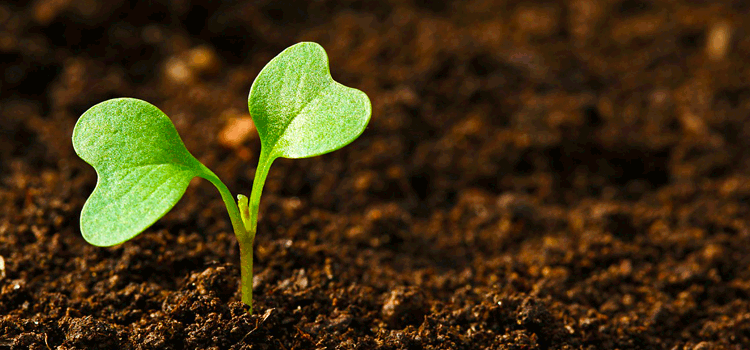 Most people know that plants grow towards sunlight. This is easy enough to test – simply turn your plants away from the light, and they will quickly turn themselves back over the course of a few days! However, seeds cannot “see” the light from the sun when they are buried underneath the soil. How do they know which way to grow when they are under the surface?
Most people know that plants grow towards sunlight. This is easy enough to test – simply turn your plants away from the light, and they will quickly turn themselves back over the course of a few days! However, seeds cannot “see” the light from the sun when they are buried underneath the soil. How do they know which way to grow when they are under the surface?
Gravity!
Plants sense light, and they can also sense the gravitational field of the earth. The British Royal Society’s Thomas Andrew Knight performed this experiment two centuries ago: He turned many seeds upside down. In the same way that a baby will find its way out headfirst, the seeds will turn themselves in the correct direction to pop out of the earth!
Knight’s exploits did not stop here. He actually proved his theory that plants sense gravity through an even crazier experiment. Placing many seeds on a spinning disc of wood, he then powered the turning of that disc with a water wheel. He sped the disc up to 150 revolutions per minute, and he kept the wheel turning for several days (long enough for the seeds to sprout). This simulated a form of gravity with a field that was unique to the seeds. It would be easy to see if the seeds were responding to gravity because their growth would be out in the open.
Knowing what we know about centrifugal force, if an object is spinning, the gravitational force will push objects away from the center. If the plants were responding to gravity on this disc, their roots should be pointed towards the outside of the disc. After a few days of nauseating spinning, this is exactly what he found!
So now we know that plants respond to gravity in an active way like we do. However, we know how we respond, and we cannot say the same for plants.
Statoliths Help Seeds Know Which Way is Up
If you remember one of the most fun facts from your high school science class, then you know that our center of balance is actually held in our ears. During the time of the above experiments, they knew this as well. The closest thing experimenters could find in plants were a collection of special cells at the very bottom of their roots. Inside the cells are dense balls that we call statoliths, or solid stones.
You might think of statoliths like heavy pebbles sitting in a jar. Of course, the pebbles will fall all the way to the bottom of the jar. This is what the statolith does inside of the plant cells that hold it. No matter which way you spin the jar, the pebbles will always respond to gravity and fall to the bottom of the jar as defined by the gravitational field around it.
This is the closest that we have come to determine how plants know which way is up. However, scientists are not sure.
One experimenter by the name of Dr. John Z. Kiss brought a bit of weight (pun intended) to this theory through a space experiment that tested the behavior of the statoliths. He hypothesized that if statoliths served the function described above when the plant is blasted into space, the statoliths should lose their “power.” They will not know which side of the jar to gravitate towards because there is virtually no gravitational field in space.
He shot his plants into space, and sure enough, he found that the roots grew in random directions. The statoliths were not able to direct the growth towards the gravitational field because there was none.
We can’t say 100% for sure, but the theory looks solid: Plants know which way is up in the same way that we do – using context clues to find the closest path to life!
